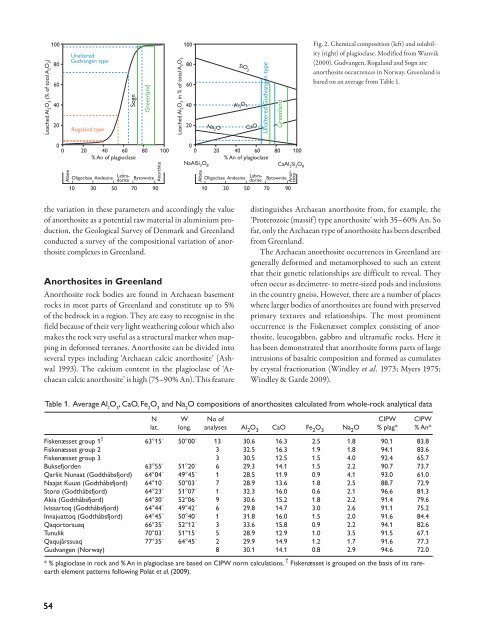Geological Survey of Denmark and Greenland Bulletin 26 ... - Geus
Geological Survey of Denmark and Greenland Bulletin 26 ... - Geus
Geological Survey of Denmark and Greenland Bulletin 26 ... - Geus
Create successful ePaper yourself
Turn your PDF publications into a flip-book with our unique Google optimized e-Paper software.
Leached Al 2<br />
O 3<br />
(% <strong>of</strong> total A 2<br />
O 3<br />
)<br />
100<br />
80<br />
60<br />
40<br />
20<br />
Unaltered<br />
Gudvangen type<br />
Rogal<strong>and</strong> type<br />
Sogn<br />
Greenl<strong>and</strong><br />
Leached Al 2<br />
O 3<br />
in % <strong>of</strong> total A 2<br />
O 3<br />
100<br />
80<br />
60<br />
40<br />
20<br />
Na 2<br />
O<br />
SiO 2<br />
Al 2<br />
O 3<br />
CaO<br />
Unaltered Gudvangen type<br />
Greenl<strong>and</strong><br />
Fig. 2. Chemical composition (left) <strong>and</strong> solubility<br />
(right) <strong>of</strong> plagioclase. Modified from Wanvik<br />
(2000). Gudvangen, Rogal<strong>and</strong> <strong>and</strong> Sogn are<br />
anorthosite occurrences in Norway. Greenl<strong>and</strong> is<br />
based on an average from Table 1.<br />
0<br />
0 20 40 60 80 100<br />
% An <strong>of</strong> plagioclase<br />
Albite<br />
Oligoclase Andesine<br />
dorite<br />
Labra- Bytownite<br />
10 30 50 70 90<br />
Anorthite<br />
0<br />
0 20 40 60 80 100<br />
% An <strong>of</strong> plagioclase<br />
NaAlSi 3<br />
O 8 CaAl 2<br />
Si 2<br />
O 8<br />
Albite<br />
Anor-<br />
thite<br />
Oligoclase Andesine<br />
dorite<br />
Labra- Bytownite<br />
10 30 50 70 90<br />
the variation in these parameters <strong>and</strong> accordingly the value<br />
<strong>of</strong> anorthosite as a potential raw material in aluminium production,<br />
the <strong>Geological</strong> <strong>Survey</strong> <strong>of</strong> <strong>Denmark</strong> <strong>and</strong> Greenl<strong>and</strong><br />
conducted a survey <strong>of</strong> the compositional variation <strong>of</strong> anorthosite<br />
complexes in Greenl<strong>and</strong>.<br />
Anorthosites in Greenl<strong>and</strong><br />
Anorthosite rock bodies are found in Archaean basement<br />
rocks in most parts <strong>of</strong> Greenl<strong>and</strong> <strong>and</strong> constitute up to 5%<br />
<strong>of</strong> the bedrock in a region. They are easy to recognise in the<br />
field because <strong>of</strong> their very light weathering colour which also<br />
makes the rock very useful as a structural marker when mapping<br />
in deformed terranes. Anorthosite can be divided into<br />
several types including ‘Archaean calcic anorthosite’ (Ashwal<br />
1993). The calcium content in the plagioclase <strong>of</strong> ‘Archaean<br />
calcic anorthosite’ is high (75–90% An). This feature<br />
distinguishes Archaean anorthosite from, for example, the<br />
‘Proterozoic (massif) type anorthosite’ with 35–60% An. So<br />
far, only the Archaean type <strong>of</strong> anorthosite has been described<br />
from Greenl<strong>and</strong>.<br />
The Archaean anorthosite occurrences in Greenl<strong>and</strong> are<br />
generally deformed <strong>and</strong> metamorphosed to such an extent<br />
that their genetic relationships are difficult to reveal. They<br />
<strong>of</strong>ten occur as decimetre- to metre-sized pods <strong>and</strong> inclusions<br />
in the country gneiss. However, there are a number <strong>of</strong> places<br />
where larger bodies <strong>of</strong> anorthosites are found with preserved<br />
primary textures <strong>and</strong> relationships. The most prominent<br />
occurrence is the Fiskenæsset complex consisting <strong>of</strong> anorthosite,<br />
leucogabbro, gabbro <strong>and</strong> ultramafic rocks. Here it<br />
has been demonstrated that anorthosite forms parts <strong>of</strong> large<br />
intrusions <strong>of</strong> basaltic composition <strong>and</strong> formed as cumulates<br />
by crystal fractionation (Windley et al. 1973; Myers 1975;<br />
Windley & Garde 2009).<br />
Table 1. Average Al 2<br />
O 3<br />
, CaO, Fe 2<br />
O 3<br />
<strong>and</strong> Na 2<br />
O compositions <strong>of</strong> anorthosites calculated from whole-rock analytical data<br />
N W No <strong>of</strong> CIPW CIPW<br />
lat. long. analyses Al 2 O 3 CaO Fe 2 O 3 Na 2 O % plag* % An*<br />
Fiskenæsset group 1 † 63°15´ 50°00´ 13 30.6 16.3 2.5 1.8 90.1 83.8<br />
Fiskenæsset group 2 3 32.5 16.3 1.9 1.8 94.1 83.6<br />
Fiskenæsset group 3 3 30.5 12.5 1.5 4.0 92.4 65.7<br />
Buksefjorden 63°55´ 51°20´ 6 29.3 14.1 1.5 2.2 90.7 73.7<br />
Qarliit Nunaat (Godthåbsfjord) 64°04´ 49°45´ 1 28.5 11.9 0.9 4.1 93.0 61.0<br />
Naajat Kuuat (Godthåbsfjord) 64°10´ 50°03´ 7 28.9 13.6 1.8 2.5 88.7 72.9<br />
Storø (Godthåbsfjord) 64°23´ 51°07´ 1 32.3 16.0 0.6 2.1 96.6 81.3<br />
Akia (Godthåbsfjord) 64°30´ 52°06´ 9 30.6 15.2 1.8 2.2 91.4 79.6<br />
Ivisaartoq (Godthåbsfjord) 64°44´ 49°42´ 6 29.8 14.7 3.0 2.6 91.1 75.2<br />
Innajuattoq (Godthåbsfjord) 64°45´ 50°40´ 1 31.8 16.0 1.5 2.0 91.6 84.4<br />
Qaqortorsuaq 66°35´ 52°12´ 3 33.6 15.8 0.9 2.2 94.1 82.6<br />
Tunulik 70°03´ 51°15´ 5 28.9 12.9 1.0 3.5 91.5 67.1<br />
Qaqujârssuaq 77°35´ 64°45´ 2 29.9 14.9 1.2 1.7 91.6 77.3<br />
Gudvangen (Norway) 8 30.1 14.1 0.8 2.9 94.6 72.0<br />
* % plagioclase in rock <strong>and</strong> % An in plagioclase are based on CIPW norm calculations. † Fiskenæsset is grouped on the basis <strong>of</strong> its rareearth<br />
element patterns following Polat et al. (2009).<br />
54

















